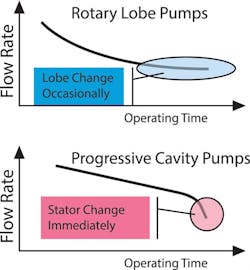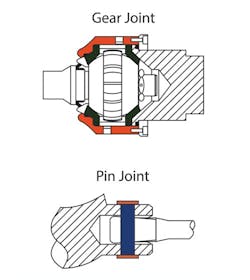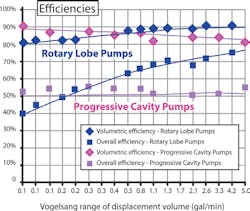Rotary lobe pumps and progressive cavity pumps are types of positive displacement pumps used to move fixed amounts of fluids. It is critical to understand the design differences between the two types when specifying which pump style is right for an application. Rotary lobe pumps are quickly becoming the preferred option for certain applications because of easier maintenance, consistent operation and flexibility.
Rotary lobe pump operation
A rotary lobe pump is designed with rounded and convoluted lobes. During operation, the two lobes fit (or mesh) together while rotating in opposite directions. This rotation forms cavities between the rotors and the casing, which are used to pump fluid from the input side to the output side. A tight cavity seal is created in one of two ways:
- The lobes are covered in an elastomeric material, which allows for slight compression against, and minimal clearance between, the pumping elements and the contoured casing.
- Running clearances are tightly restricted. This reduces the slip (leakage) between the metal-to-metal circumferential piston designs.
Progressive cavity pump operation
A progressive cavity pump displaces a fixed volume of liquid with each revolution. The rotor (a single helix design) rolls “eccentrically” within the stator (a double helix design). This design combination creates cavities, or voids, which move toward the pump’s discharge end as the rotor turns. Each cavity within the pump has a complete seal line, which reduces the amount of slip in each pump revolution and are critical to performance. A progressive cavity pump requires a moving linkage that will allow the drive to work with the eccentrically turning stator – typically pin joints, flexible shafts and gear joints. The pump’s capacity is determined by the size of the cavity formed when the rotor is placed inside the stator.
Rotary lobe pump advantages
When determining which style of pump to use, the engineer must evaluate the application, including installation considerations, the type of material being pumped, the level of flow and the pressures involved. In many applications, a rotary lobe pump and a progressive cavity pump can accomplish the same goal: moving fluid. However, rotary lobe pumps have become the preferred option for many fluid control applications given their rugged performance, small footprint and reduced maintenance.
Smaller size
Compared to a progressive cavity pump with a capacity of 200 gallons per minute (gpm) or greater, a rotary lobe pump typically requires approximately half the amount of space and half the working room for maintenance. Some pump manufacturers can configure rotary lobe pumps to be even smaller without sacrificing performance. This is a significant benefit for many industries that require the functionality of a positive displacement pump, but have tight spatial requirements.
Easier service
Rotary lobe pumps are smaller and require less room for maintenance than progressive cavity pumps. They are maintained in place, meaning wear plates, seals and lobes can be replaced without removing any connected piping, and can often be accessed by simply removing a section of the pump’s housing. Rotary lobe pumps can usually be serviced by one worker and do not require any lifting equipment.
Progressive cavity pumps are generally larger than rotary lobe pumps and they require connected piping to be removed and the pump to be disassembled to maintain components in the wet end. Larger progressive cavity pumps may also require multiple service staff members or heavy lifting equipment to handle parts when performing maintenance.
Wear situation operation
Rotary lobe pumps are able to run effectively even with a significant amount of lobe wear. Additionally, abrasion becomes less the longer the pump operates because wear is caused by back-flow velocity and not by contact abrasion (see Figure 2, top curve). Because of the high-speed limits of rotary lobe pumps, internal leakage caused by wear can always be compensated for by increasing the pump’s speed.
While a progressive cavity pump’s speed can also be increased to compensate for internal leakage, limitations exist. If the stator wears to the point where tight contact no longer exists between the rotor and stator, the pump would need immediate maintenance to avoid a rapid acceleration in abrasive wear (See Figure 2, lower curve).
Figure 2. Flow rate over time: rotary lobe pumps versus progressive cavity pumps
Pin joints & gear joints
A progressive cavity pump must transfer the rotor’s eccentric motion to the radial movement of the drive shaft, as well as transfer the torque and thrust loads. This is accomplished through the use of pin joints and gear joints. These joints are metal-to-metal contacts, which have limited life spans.
Pin joints and gear joints typically sit immersed in the fluid being pumped, which makes them prone to excessive wear. Gear-jointed pumps have an additional set of problems. Gear joints require lubrication, which increases maintenance requirements and can be problematic since the lubricant can be eroded by the pumped fluid. Regular inspection of the gear is critical, yet difficult, because an operator must remove the pump from service and disassemble the unit – No other way exists to visibly inspect the gear. Repairs are typically not cost-effective since the cost of gear joint replacement exceeds that of a rotor and stator replacement on some pump models.
Rotary lobe pumps do not require gear joints or pin joints. The motion energy of the motor is transferred directly to the rotary lobes through the drive shaft, which is meant to eliminate the potential for problems.
Figure 3. Pin joints and gear joints have different maintenance needs.
Rotary lobe pump efficiencies
When determining efficiency, one must evaluate volumetric efficiency and overall efficiency separately. Volumetric efficiency characterizes the pump’s tightness. Small progressive cavity pumps (with small displacement volumes) normally have higher volumetric efficiencies than small rotary lobe pumps. Comparatively, larger rotary lobe pumps (with high displacement volumes), have better volumetric and better overall efficiencies.
Overall efficiency accounts for internal leakage and the torque created from internal friction. Figure 4 illustrates that the tight seal in a progressive cavity pump is achieved only with high torque. Additionally, the running torque of progressive cavity pumps increases as fluid temperatures rise because of rubber expansion.
Dry run capability
Positive displacement pumps are often forced to run dry because of system requirements or accidental operation. When a progressive cavity pump runs dry, the tight contact between the rotor and stator increases friction. This friction causes the temperature to quickly rise and consequently destroys the stator.
Rotary lobe pumps are designed so the rotor does not touch any part of the housing. This allows the pump to run dry with only a small increase in temperature and without the risk of damage to any part of the unit.
Figure 4. Efficiencies: Rotary lobe pumps versus progressive cavity pumps (based on values measured while pumping water at 70°F with 58 psi differential pressure)
A growing preference for rotary lobe pumps
While rotary lobe pumps and progressive cavity pumps are types of positive displacement pumps, the design of each unit results in several operational differences. A rotary lobe pump is typically able to move material more consistently – efficiently handling viscous liquids, pastes and abrasives. These units are able to effectively pump solids (abrasive matter), which reduces unscheduled maintenance and provides longer periods of time online. In most installations, rotary lobe pumps are easier and faster to service when maintenance is needed. These factors, combined with a smaller footprint, make rotary lobe pumps the preferred choice for a variety of applications.
For almost 20 years, Russell Boring has been the president of Vogelsang, one of the world’s leading pump, grinder and process equipment manufacturers. Boring may be contacted at 330-296-3820, ext. 222, or [email protected].





